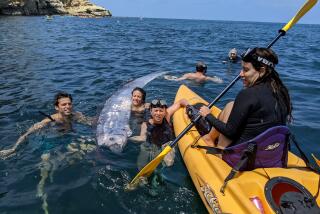Walking on its fins: Hindquarters of fossil fish surprise scientists
You’ve met the front of Tiktaalik roseae, the fish-like creature that fills an important gap between fish and four-legged, land-based animals. Now, the hindquarters of the 375-million-year-old fossil are having their close-up moment, and they’re showing a pelvis that marks it farther along the evolutionary track from fin to limb.
Discovered in the Canadian Arctic in 2004, and introduced to the scientific world two years later, Tiktaalik roseae demonstrates the predictive power of Darwin’s theory of evolution -- a transitional creature found on the timeline precisely where the theory assumed it ought to be.
MORE: How our ancestors moved out of the sea
Tiktaalik, an Inuit word for “large, freshwater fish,” had a skeletal structure that likely allowed it to support itself with its front and back fins, and “walk” with them, at least in shallow waters, according to a study published Monday in the journal Proceedings of the National Academy of Sciences.
“They’re largely committed to water,” said University of Chicago evolutionary biologist Neil H. Shubin, lead author of the study. “They probably can take some forays onto land, but they were using these hind fins to move about in the water bottom, in the shallows and maybe in the mud flats, where they could use their fins either as a paddle or to walk, as a lot of fish do, in the water.”
Shubin and fellow researchers hadn’t expected to find out much from the animal’s hindquarters. Forced to cut the rock specimen in half to transport it home, they first prepared the front of the specimen -- where such features as an independently moving skull, rib cage, and pectoral fin would help define its position on the evolutionary tree. Those features, which gave Tiktaalik a kind of crawling ability, earned it the “fishapod” nickname -- a cross between a fish and tetrapod, or four-legged animal.
Since most fossils of creatures on the fish side of the gap don’t show much evidence of a robust rear fin or large pelvis, Shubin’s team had low expectations. So they were surprised by what they uncovered.
“We saw a series of ribs that fit very much with the front block and then -- boom -- saw this giant pelvis and giant hind fin,” said Shubin. “The size of that pelvis totally surprised me. I was expecting to find something much smaller. Most creatures at this stage of evolution had emphasized the forefins and the hind fins are actually kind of small.”
Tiktaalik, nonetheless, was not fully a tetrapod, Shubin said. Before such animals could have thrived on land, he said, “there are a lot of changes that still had to happen.”
Tiktaalik’s pelvis is not attached to its ribs, an important feature that would help it support itself on land, where it could not depend on the buoyancy of its aquatic domain.
“The other thing that the earliest tetrapods have but Tiktaalik doesn’t is a bone called the ischium, which is a bone that faces posteriorally, or caudally,” Shubin added. “We have one; early tetrapods have one; Tiktaalik does not. What that is good for is for muscles that retract the leg.”
The ischium is the bone you can feel when sitting on a hard surface, and it’s where the leg muscle system that includes the adductors attaches.
Besides lacking that butt bone, Tiktaalik had a hip joint that faced rearward, not laterally, as it does in tetrapods and in bipeds like us.
“Tiktaalik is very intermediate in that regard,” said Shubin.
Tiktaalik’s pelvis nonetheless offered plenty of surfaces where muscle likely attached, giving it strength and a relatively wide range of motion.
The unearthing and analysis of Tiktaalik’s hindquarters also brought other benefits. Specimens collected previously, but labeled with question marks, were positively identified as Tiktaalik pelvises, giving the team four additional specimens of the crucial skeletal feature.
The research team also included Edward B. Daeschler, of the Academy of Natural Sciences at Drexel University, Philadelphia. One member of the original team that unearthed Tiktaalik, Farish Jenkins, Jr., of Harvard University, died in 2012.







